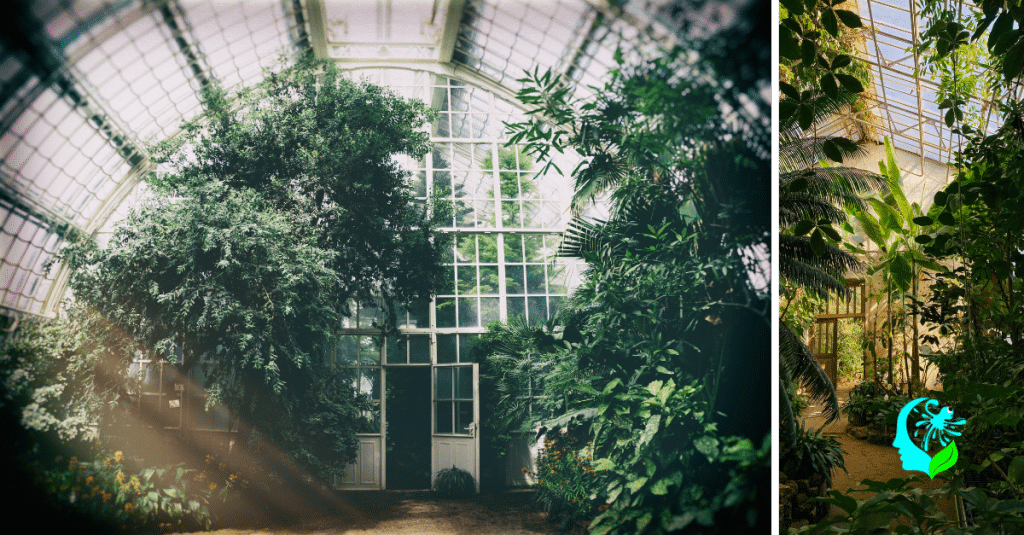Solar-Powered Greenhouses for Bountiful Year Round Harvests Off-Grid
Transform your gardening with solar-powered greenhouses that combine renewable energy and smart design for year-round harvests without grid connection. Whether using passive solar techniques or advanced PV systems, these structures maintain ideal growing conditions even in freezing temperatures.

Key Takeaways
- Solar-powered greenhouses combine renewable energy with innovative design to enable year-round food production without connecting to the electrical grid.
- Passive solar greenhouses use natural heat retention through strategic orientation and thermal mass, while active systems incorporate photovoltaic panels to power automated climate control systems.
- The geodesic dome design offers superior solar gain and structural strength, making it particularly effective for off-grid applications in areas with extreme weather.
- UpRooted Greens specializes in implementing sustainable greenhouse systems that maximize food production while minimizing environmental impact.
- With proper insulation and energy storage solutions, solar greenhouses can maintain optimal growing conditions even in freezing temperatures, extending growing seasons dramatically.
Solar-Powered Greenhouses: The Ultimate Solution for Year-Round Off-Grid Harvests
Imagine harvesting fresh tomatoes in the dead of winter without a massive heating bill or even a connection to the electrical grid.
Solar-powered greenhouses make this dream a reality, transforming how we grow food in a world of rising energy costs and climate uncertainty. As a sustainable solution for year-round food production, UpRooted Greens has seen firsthand how these innovative structures revolutionize local food systems by enabling growers to produce fresh vegetables regardless of external climate conditions.
These specialized growing environments harness the sun's abundant energy to create ideal conditions for plants, even in remote locations without access to conventional power sources. Unlike traditional greenhouses that often require substantial external heating, solar greenhouses utilize specific design principles to capture, store, and efficiently use solar energy.
This goes far beyond simply placing a standard greenhouse in a sunny spot – it involves strategic orientation, specialized materials, and systems designed specifically to maximize energy efficiency while creating optimal conditions for plant growth.
How Solar Greenhouses Work: Passive vs. Active Systems
Solar greenhouses operate using two fundamental approaches: passive and active solar systems. Each has distinct advantages and can be implemented based on your specific needs, climate, and budget.
Passive Solar Design: Harnessing Natural Heat Retention
Passive solar greenhouses rely on architectural design, positioning, and materials to collect, store, and distribute solar energy without mechanical systems. These greenhouses work on simple yet effective principles:
- Strategic orientation: The greenhouse is positioned with its longest side facing true south (in the Northern Hemisphere) to maximize sun exposure during winter months when the sun is lower in the sky.
- Thermal mass: Materials with high heat capacity like water barrels, stone, concrete, or soil absorb solar energy during the day and release it gradually at night. These thermal batteries maintain more consistent temperatures, preventing the extreme fluctuations that can stress plants.
- Insulation: The north, east, and west walls are heavily insulated to prevent heat loss, while the south-facing wall uses transparent glazing to admit maximum sunlight.
- Proper glazing angles: The transparent covering is angled to optimize solar gain based on your latitude, capturing more energy during winter months.
The Chinese solar greenhouse exemplifies passive design excellence. Developed over centuries in northern China, these structures feature a heavily insulated north wall (often several feet thick), east and west end walls with minimal glazing, and a south-facing transparent wall that slopes to optimize winter sunlight capture. This simple yet effective design can maintain growing temperatures even when external temperatures drop well below freezing, using minimal supplemental heat.
Active Solar Systems: Adding Photovoltaic Power and Automation
Active solar greenhouses incorporate technology to enhance and control the growing environment. They typically include:
- Photovoltaic (PV) panels: Solar panels convert sunlight directly into electricity to power greenhouse systems.
- Battery storage: Energy captured during sunny periods is stored for use during nighttime or cloudy conditions.
- Charge controllers: These prevent battery damage by regulating the voltage and current coming from solar panels.
- Climate controllers: Automated systems monitor and adjust temperature, humidity, and ventilation based on programmed settings.
- Powered components: Electric systems may include ventilation fans, irrigation pumps, supplemental lighting, and heating elements.
Active systems provide greater control and precision, allowing you to maintain ideal growing conditions regardless of external weather. They work particularly well in regions with extreme temperatures or for growing crops with specific climate requirements.
Energy Storage Solutions for 24/7 Operation
For truly off-grid reliability, energy storage is necessary. Solar greenhouses employ several methods to ensure continuous operation:
- Battery banks: Deep-cycle batteries store electrical energy from solar panels for use during non-sunny periods. Lithium iron phosphate (LiFePO4) batteries work well for greenhouse applications due to their longer lifespan and better performance compared to traditional lead-acid batteries.
- Thermal mass storage: Beyond the passive benefits, active systems can incorporate water tanks or rock beds that are heated during the day using excess solar energy, then circulated at night to warm the greenhouse.
- Earth tubes: Also called ground-to-air heat exchangers, these underground pipes use the stable temperature of the earth (typically 50-60°F at depth) to pre-warm incoming air in winter and cool it in summer.
- Phase change materials: These specialized substances absorb and release heat at specific temperature thresholds, providing concentrated thermal storage in a compact space.
By combining passive design principles with active solar technology, modern off-grid greenhouses can create remarkably stable growing environments with minimal external inputs.
4 Solar Greenhouse Types for Different Needs and Budgets
1. Chinese Solar Greenhouses: Maximum Insulation with Minimal Technology
The Chinese solar greenhouse (or "solar lean-to") design has been refined over generations in northern China, where growers have cultivated vegetables through harsh winters without fossil fuels. These structures feature:
- A solid, heavily insulated north wall that blocks cold winds and reflects light
- A transparent south-facing wall, often with removable insulation blankets for nighttime
- Thermal mass within the structure to store daytime heat
- Minimal to no supplemental heating requirements, even in sub-freezing temperatures
These greenhouses excel in northern climates with cold winters and limited resources. Their beauty lies in simplicity and effectiveness through passive design rather than technology. With proper construction, they can maintain growing temperatures 25-40°F above outside temperatures without supplemental heating.
2. Polytunnels: Affordable Season Extension Options
Polytunnels (also called hoop houses) represent the most accessible entry point into solar greenhouse growing:
- Simple construction using bent metal pipes or PVC covered with greenhouse plastic
- Quick setup with minimal specialized skills required
- Low initial investment compared to other greenhouse types
- Effective season extension capabilities
While basic polytunnels lack the insulation and thermal mass of more sophisticated designs, they can be enhanced with solar features. Adding roll-up sides for ventilation, thermal mass containers filled with water, and proper orientation can transform a simple hoop house into an effective passive solar greenhouse.
3. Fully-Automated Solar Greenhouses: Complete Climate Control
At the high-tech end of the spectrum, fully-automated solar greenhouses integrate renewable energy with advanced climate management systems:
- Photovoltaic array providing electricity for all systems
- Battery storage for 24/7 operation
- Automated ventilation, irrigation, and temperature control
- Real-time monitoring and remote management capabilities
- Potential for hydroponic or aquaponic integration
These systems provide the most precise growing environment but require significant investment in both equipment and technical knowledge. They work best for commercial operations or situations where maximum yield and year-round production justify the higher initial costs.
4. Geodesic Domes: Efficient Design for Extreme Weather Conditions
Geodesic dome greenhouses have gained popularity for their unique structural and thermal advantages:
- Spherical shape provides maximum interior volume with minimum surface area
- Excellent wind resistance and structural strength in harsh conditions
- Superior light diffusion throughout the day as the sun moves across the sky
- Efficient heat distribution due to natural air circulation patterns
Dome greenhouses are particularly well-suited for off-grid locations with extreme weather. Their aerodynamic shape sheds wind and snow loads effectively, while their surface-to-volume ratio minimizes heat loss. Though more complex to construct than traditional shapes, pre-fabricated kits have made dome greenhouses increasingly accessible.
Essential Infrastructure for Off-Grid Production
Solar Power Systems: Panels, Batteries and Controllers
The heart of any active solar greenhouse is its power generation system. Key components include:
- Solar panels: Monocrystalline panels typically offer the best efficiency for limited space applications. For greenhouse use, 400-1000 watts of generation capacity provides a solid starting point for basic systems.
- Battery storage: Deep-cycle batteries store energy for nights and cloudy days. Lithium iron phosphate (LiFePO4) batteries work well for greenhouse applications due to their long cycle life and safety, though quality lead-acid batteries remain a more affordable option.
- Charge controllers: These critical components prevent battery damage by regulating charging. MPPT (Maximum Power Point Tracking) controllers maximize energy harvest and are worth the additional investment over simpler PWM controllers.
- Inverters: Convert DC battery power to AC for standard appliances and equipment. Pure sine wave inverters are recommended for sensitive electronics like climate controllers.
Thermal Mass Solutions for Temperature Regulation
Effective thermal mass is crucial for maintaining stable temperatures:
- Water storage: 55-gallon drums painted black and filled with water provide excellent heat storage capacity (one gallon of water can store about 8 BTUs per degree Fahrenheit).
- Stone or concrete: Dense materials beneath or within the growing space absorb daytime heat and release it slowly overnight.
- Phase change materials: Specialized compounds that absorb and release heat at specific temperature thresholds offer concentrated thermal storage in limited spaces.
The ideal amount of thermal mass depends on your climate and greenhouse size. As a general guideline, aim for 2-3 gallons of water (or equivalent mass) per square foot of glazing in cold climates.
Setting Up Your Solar Greenhouse
1. Site Selection and Orientation for Maximum Sun Exposure
Proper siting is the foundation of an efficient solar greenhouse:
- Choose a location with unobstructed southern exposure (northern exposure in the Southern Hemisphere)
- Avoid shadows from buildings or trees, especially during winter months when the sun is lower
- Orient the greenhouse with its long axis running east to west
- If possible, position on a slight south-facing slope for additional solar gain and natural drainage
Maximizing Your Self-Sufficiency with Solar Greenhouse Technology
Solar-powered greenhouses represent one of the most powerful tools for food independence and sustainability. By combining time-tested building practices with modern renewable energy technology, these systems enable year-round production with minimal external inputs. From simple season extension to complete climate-controlled environments, solar greenhouse technology can be scaled to fit every situation and budget.
Whether you want to extend your growing season by a few weeks or create a complete food production system that operates independently from the grid, the principles and approaches outlined here provide a foundation for success. The future of sustainable food production connects natural systems with renewable resources, and solar greenhouses stand at the forefront of this movement.
For expert guidance on implementing solar greenhouse technology for your specific needs, UpRooted Greens offers consultation services to help you design and implement the perfect solution for your climate and growing goals.
